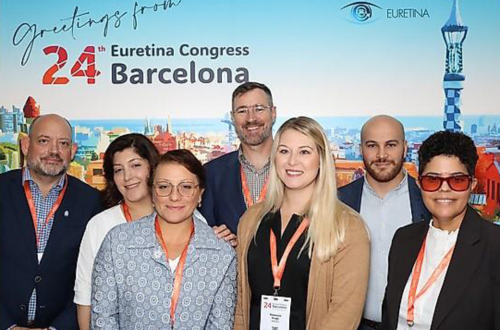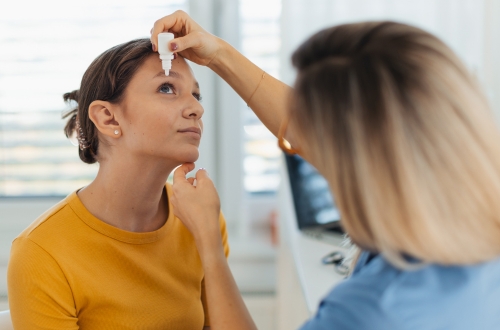Top 10 Insights from Euretina 2024
It’s well known that the world is currently in the midst of a longevity revolution. According to the United Nations (UN), older people account for more than one fifth of the population in 17 countries today. Fast forward to 2050, the UN expects one in six individuals will be aged 65 years or older globally, a number up from one in 11 in 2019. With such trends of an aging population, we must also contend with increasing prevalence rates of conditions like diabetic retinopathy, age-related macular degeneration (AMD), and glaucoma. As of 2023, the World Health Organization (WHO) predicted that vision impairment poses a global productivity cost of about U.S. $411 billion each year. These numbers collectively indicate the growing burden of age-related ophthalmology conditions on healthcare systems worldwide and highlight the immediate need for cutting-edge research in vision care.
Recognizing this, the European Society of Retina Specialists hosted their 24th annual Euretina Congress in Barcelona, Spain from September 19-22. The 2024 Congress was a hub for the world’s leading experts in ophthalmology, including esteemed members of the TFS Ophthalmology contract research organization (CRO) team. From four days of showcasing the latest research and innovative treatments for retinal diseases, TFS shares the top 10 insights from Euretina 2024 in this article.
Keep reading and dive into the latest therapeutic developments in ophthalmology!
1. AI-Driven Advances are Streamlining Retinal Imaging Workflows
Among their many innovations presented at Euretina 2024, Zeiss Medical Technology showcased their CIRRUS PathFinder, which is a deep learning artificial intelligence (AI) tool that is designed to streamline the review and documentation of imaging data obtained with optical coherence tomography (OCT). As a refresher, OCT is a non-invasive imaging test that uses light waves to take cross-sectional pictures of the retina. Using CIRRUS PathFinder, technicians and ophthalmologists can leverage AI to rapidly extract information from large volumes of diagnostic data to provide insights into optimal treatment regimens and care strategies for patients.
Zeiss also debuted its Surgery Optimizer at Euretina 2024, another AI tool meant for easy export, review, and documentation of ophthalmology surgery videos. The company announced it will also have a spatial computing app compatible with Apple Vision Pro that will allow surgeons to view surgery videos, eye scans, and patient information simultaneously in 2D and 3D. Read the full article here.
2. New Gene Therapy Offers Hope for Treating Inherited Retinal Diseases
The Euretina 2024 Congress saw multiple presentations highlighting the key role of gene therapy when treating patients with inherited retinal diseases. For example, in a real-world study from the United Kingdom, 14 eyes in eight patients (two adults and six children) with two types of inherited retinal disease — retinitis pigmentosa (RP) and Leber congenital amaurosis (LCA) — were treated with voretigene neparvovec. This drug, also known as Luxturna, is the only ocular gene therapy approved by the United States (U.S.) Food and Drug Administration (FDA). The study found the earlier this treatment is administered, that is in children whose photoreceptors are not yet irreversibly damaged, the more it can preserve the patient’s visual function. Read the full article here.
A different open-label, dose-escalating, first-in-human Phase 1/Phase 2 study treated 12 patients with Bothnia Dystrophy with various doses of the subretinal experimental gene therapy, AAV8-RLBP1. Bothnia Dystrophy is a rare form of retinitis pigmentosa that usually presents in early childhood and eventually progresses to night blindness and subsequent legal blindness. In addition to demonstrating acceptable safety and tolerability, AAV8-RLBP1 enabled sustained recovery from very delayed dark adaptation (DA) at one (8 of 12 patients), two (11 of 12 patients), and three hours (9 of 12 patients). Patients also reported improvements in daily activities. Read the full article here.
3. Exploring Gene Editing Approaches for CRB1-associated Retinal Dystrophy
The second-place prize for the August Deutman award at Euretina 2024 was granted to Dr. Hoda Shamsnajafabadi, who presented a study that identified three pathogenic CRB1 variants, including a novel c.2833G>A variant, associated with early-onset cone-rod dystrophy. Her groundbreaking research suggested that CRISPR-Cas mediated adenine base editing could be a suitable therapeutic approach for all three of these variants of CRB1-related retinal dystrophy. In addition to demonstrating the life-changing potential that CRISPR technology could have when addressing genetic retinal diseases, this study also opens new avenues for further investigating future gene editing methods in ophthalmology. Dr. Shamsnajafabadi also emphasized the importance of developing new tools that can optimize patient selection processes for CRISPR studies and improve the generalizability of their findings. Read the full article here.
4. Innovations in Drug Delivery Systems Offer Improved Patient Experiences
There have been notable developments in newer ophthalmology drug delivery systems that could enhance both patient experiences and treatment outcomes. Specifically, the Port Delivery System (PDS) with ranibizumab, also known as Susvimo, emerged as a more convenient solution for patients with diabetic macular oedema (DMO). The PDS was evaluated in the Phase 3 Pagoda clinical trial (NCT04108156), with its recent year 2 findings demonstrating that Susvimo, when refilled every 6 months, can maintain visual and anatomical improvements comparable to traditional intravitreal injections.
The greatest value of this drug administration approach is that it reduces the treatment burden on patients with DMO, with 83% of participants expressing a preference for Susvimo over conventional injections. Rather than having to visit the clinic multiple times for separate administrations, the PDS provides continuous drug delivery that promises greater comfort in long-term care of these patients. The study also underscores why it is important for researchers to consider patient preferences and their quality of life when developing new treatment options. Read the full article here.
5. Digital Technology Improves Surgical Precision for Retinal Disorders
Another significant focus at Euretina 2024 was Zeiss Medical Technology’s digital advancements in surgical techniques for ophthalmology disorders. Among their developments was the ARTEVO 850 3D digital ophthalmic microscope, which makes both anterior and posterior segment surgeries of the eye possible, while enabling customization with 3D visualization, true-color imaging, and an expanded depth of field. With this tool, vitreoretinal surgeons can rely on real-time intraoperative OCT imaging to make more accurate and informed decisions when operating. At this year’s congress, Zeiss also presented single-use lenses for their RESIGHT fundus viewing system, which serves to provide surgeons with a clear view for every procedure during ophthalmic procedures. Read the full article here.
6. The Growing Need for Real-World Evidence (RWE) in Ophthalmology
Recent results from the VOYAGER study demonstrated the importance of real-world evidence (RWE) in ophthalmology at Euretina 2024. VOYAGER is a global study that has been following the clinical and physiological outcomes of faricimab, specifically in treatment-naïve patients with neovascular age-related macular degeneration (nAMD) or diabetic macular edema (DME). In patients with DME, faricimab treatment resulted in increased mean visual acuity from baseline to month six by +7.2 ETDRS letters. There was also a reduction in clinician-reported intraretinal fluid, present in 98.2% of DME eyes at baseline and in 72.7% after 6 months.
RWE studies like VOYAGER, which spans 28 countries worldwide, allows for the collection of data from a more heterogeneous group of patients, often including those who might be excluded from traditional clinical trials. Therefore, the importance of accumulating a large body of RWE lies in its ability to help clinicians make more informed decisions about patient care and treatment strategies, while potentially revealing long-term effects and rare side effects that shorter-duration clinical trials may not have observed. Read the full article here.
7. Understanding Genetic Links between Hearing Loss and Inherited Retinal Diseases
Usher syndrome is a rare genetic disease that causes deafness or hearing loss, the retinal disease retinitis pigmentosa (RP), and sometimes can affect balance. Patients with Usher syndrome are typically born with it or will be diagnosed as a child or teenager. Dr. João Pedro Marques and his team from Portugal presented a study at Euretina 2024 that sheds light on the many genetic conditions that contribute to simultaneous auditory and visual impairment. Although Usher syndrome was the most frequent etiology (71.4%) in patients with clinically diagnosed hearing loss and retinal dystrophy, genetic testing methods also identified other diseases, including PHARC syndrome (6.0%), autosomal dominant optic atrophy plus (4.8%), and cone-rod dystrophy with hearing loss (4.8%). This genetic profile indicates why we must raise awareness about the heterogeneity in dual sensory loss among ophthalmology professionals. According to this same study, only 59.5% of patients were referred for genetic testing/counseling by ophthalmologists, highlighting a gap in timely referral in these patients. Read the full article here.
8. Key Risk Factors Identified for Post-Operative Rhegmatogenous Retinal Detachment
In a late-breaking abstract presented at Euretina 2024, a comprehensive analysis of cataract surgeries across the United Kingdom (UK) revealed key risk factors for post-operative rhegmatogenous retinal detachment (RRD). The study collected data from over 843,000 surgeries reported to the Royal College of Ophthalmologists’ National Ophthalmology Database Audit. They found that younger age, male gender, history of RRD or vitrectomy, higher axial lengths, and worse preoperative visual acuity contributed to the occurrence of RRD within the first year after cataract surgery. These associations demonstrated high accuracy within the study’s predictive model and the researchers highlighted the importance of tailoring a detailed follow-up care plan for these high-risk patients. This is especially crucial in those who experience posterior capsule rupture or left aphakic after their cataract surgery, as it increases the risk of a serious postoperative complication like RRD. Read the full abstract here.
9. Recent Developments in Retinal Imaging Emerge Using RGB Imaging Modalities
In addition to AI-based imaging innovations in ophthalmology, Euretina 2024 also saw new developments in retinal imaging using RGB (Red-Blue-Green) imaging modalities. The relevance of integrating RGB color wavelengths into imaging systems is that it significantly improves image quality by addressing the greenish tones often seen in OCT scans. The study showcased at this year’s conference was conducted at Lariboisière Hospital in Paris, finding that RGB-based imaging allows for deeper penetration through cataracts, which is a common challenge in patients with diabetes. The result is a clearer visualization of the retina, which allows for more accurate diagnoses in clinical practice. According to the researchers, this new imaging system was able to better detect hemorrhages, microaneurysms, and intraretinal micro abnormalities, which can indicate diabetic retinopathy severity more precisely. Read the full article here.
10. Anti-VEGF Therapy May Help Treat Children with Retinopathy of Prematurity
The National Eye Institute defines retinopathy of prematurity (ROP) as an eye disease where abnormal blood vessels are present in the retina, causing visual impairment; it often occurs in babies who are born prematurely. Presented at Euretina 2024, FIREFLEYE is a Phase 3B study that is following children aged 0-3 years old treated for severe acute-phase ROP with either aflibercept or laser therapy. Aflibercept is an intravitreal anti-VEGF therapy that is also used to treat wet macular degeneration, and in this clinical study, 0.4 mg of the drug demonstrated effective and well-tolerated long-term control of ROP in young children.
Relative to the group treated with conventional laser therapy, children who received aflibercept experienced fewer cases of severe myopia and greater improvements in visual outcomes, with more participants in this group achieving binocular best corrected visual acuity (BCVA) ≥20/40. Furthermore, high myopia occurred less frequently in aflibercept-treated eyes and the majority of children showed no ROP by 3 years of age. Overall, the findings from this FIREFLEYE study indicate that anti-VEGF therapy with aflibercept could offer a durable and effective treatment option for ROP over laser therapy in young patients. Read the full abstract here.
Conclusion
In conclusion, September 2024 closed out this year’s pivotal Euretina Congress, showcasing several exciting advancements emerging in the field of ophthalmology. The conference highlighted innovative AI-drive diagnostics, novel clinical treatments for age-related eye conditions, as well as highlighted the importance of RWE, genetic testing, and personalized care for retinal diseases. Other technologies like RGB imaging and PDS approaches to drug delivery were also presented, promising enhanced diagnostic accuracy and patient comfort during clinical care. As our global population continues to age, these insights and technological developments shared at Euretina 2024 will become crucial for addressing the growing burden of eye diseases and delivering better visual health to patients.
About TFS HealthScience Ophthalmology CRO
Experience the difference with TFS HealthScience Ophthalmology CRO for your next ophthalmology clinical trial! With a global mindset and local understanding, we provide a comprehensive suite of services, including study protocol design, medical monitoring, and project delivery. Our experienced teams and innovative technology ensure efficient delivery, no matter the complexity. Trust TFS HealthScience to take your study to the next level with our dedicated Ophthalmology team. Visit TFS Ophthalmology CRO’s website to learn more about the data-driven solutions TFS can offer for your next clinical trial or connect with a TFS representative here!
Interested in more Ophthalmology CRO content from TFS? Visit our Intellect Hub here to access white papers, articles, case studies, and more!
Connect with Us
Contact us today to discover how TFS can be your strategic CRO partner in clinical development.


